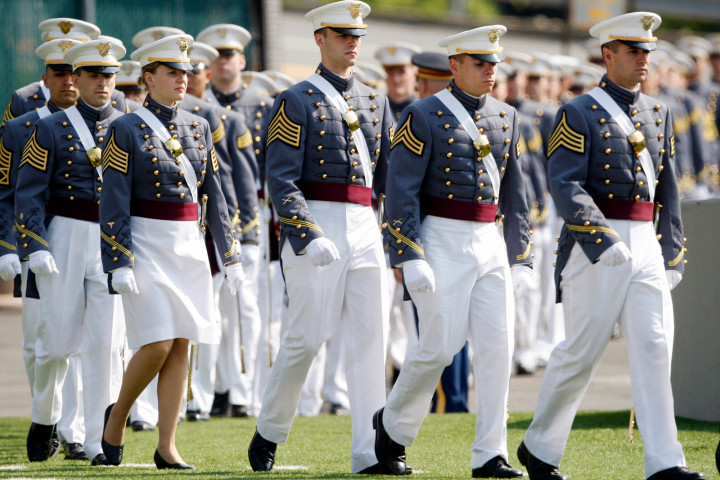Seth Lipsky New York Post
When graduates of West Point’s Class of 2016 go into their years of service as officers of the Army, they will be wearing something no other cadets have worn before — class rings that include steel from the World Trade Center.

Cadets march into Michie Stadium before a graduation and commissioning ceremony at the US Military Academy at West Point.
Photo: AP
It hasn’t received mention in the press. But it was movingly noted Friday in the introduction of the commandant of cadets, Brig. Gen. John Thomson III, at the military academy’s annual ring memorial ceremony.
What a cure for the cynicism of a cynical age. It’s at the ring ceremony that seniors — known as “firsties” — get their rings, which become a physical link between future officers and the West Point graduates who went before.
The ceremony takes place at one of the most beautiful places in America — Trophy Point. The trophies, which are cannons captured in 1812 and other wars, look out over a slope giving north into the Hudson River.
Class of 2016 cadets were marched — to a cadence set by trumpets, pipes and drums — onto this slope. They passed Stanford White’s famous battle monument, topped with a statue of “Fame.”
The Army knows how to do ceremonies like few other American institutions. The cadets are dressed in a uniform called India Whites, worn only by West Point cadets.
There are about 1,000 cadets in the Class of 2016, and it takes a while for them to be marched in. It’s an important enough event that parents and relatives, girlfriends and boyfriends have come from across the country.
Each class designs its own rings. The ingots of the Class of 2016’s rings were poured earlier in the year at the Pease & Curren refinery in Rhode Island. That ceremony, known as the “ring melt,” is a tradition begun for the rings of West Point’s bicentennial class in 2002.
Since then, it’s not just any gold that goes into these rings. They’re made from gold from class rings that were worn by earlier graduates and that have been donated, melted and mixed with new gold to make rings for the following year’s first-class cadets.
A small amount of gold is preserved after each melt so that every graduating class will have traces of gold from all the rings that have been donated since the program began.
This has enabled every class since 2002 to “grip hands” with graduates from the past.
This year, 34 class rings were donated from classes between 1924 and 1985. Some families donating rings sent family members to the ring melt, where they placed the rings in a crucible. A film of the event shows a number of them, including Tom O’Neil, who donated the ring worn by his grandfather.
The grandfather, Col. Thomas O’Neil, had been in the Class of 1934. His grandson had carried his ring through two combat tours in Iraq and two years in Afghanistan. At the ring melt, he spoke of what the moment would have meant to his grandfather.
Five daughters of Col. Leo Hugh Lennon, who had been in Vietnam during the Tet Offensive, placed his class ring in the crucible. Others did the same, some saluting.
This new tradition has brought to 356 the number of rings whose gold is in the latest ingot.
It was the Class of 2016 itself that decided to include in the alloy of the rings for this year steel from the World Trade Center, Cathy Kilner of the Association of Graduates tells me.
“They were raised seeing the footage of what happened and the consequences of that day,” she said. I like the way she put it — “the consequences of that day.”
It’s not that there is anything political about the ring ceremony (or anything else) at West Point. There’s not, so far as I can tell, having visited the place now and again since the 1950s. It really is about forging a sense of duty, honor, country — and the Corps.
Toward the end of the ring memorial ceremony, the cadets are ordered to “reeee-cover,” meaning put their hats back on, and are dismissed. They make their way up the slope and across the plain, past the statues of Sylvanus Thayer, George Patton, Dwight Eisenhower and George Washington.
When they get to their sally ports — as the dorm entryways are known — tradition requires they stride through a mob of plebes, pleading to touch their rings and testing their ability to keep walking with their heads — and, in this case, their memories of the World Trade Center — held high.

